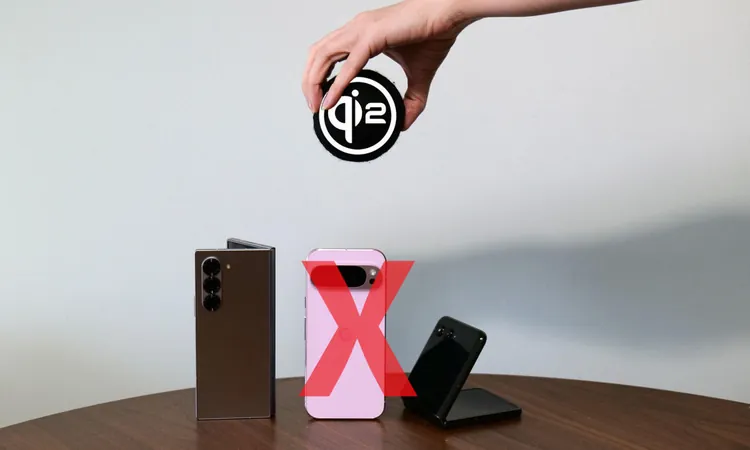
Android Phone Makers Fail to Embrace Qi2 in 2024: A Missed Opportunity!
2024-12-24
Author: Benjamin
Introduction
In the ever-evolving landscape of smartphone technology, Android phone manufacturers have historically been pioneers, leading the charge in adopting new standards. From being the first to embrace 4G and 5G networks to integrating USB-C ports and in-screen fingerprint sensors, Android has often taken the lead. Wireless charging is another area where these devices have made strides, with the Samsung Galaxy S3 marking the beginning of this trend back in 2012. However, as we enter 2024, it's surprising—and somewhat disappointing—to see the lack of support for the Qi2 wireless charging standard among Android device makers.
The Qi2 Standard Unveiled
The Qi2 standard was unveiled at CES 2023 with great fanfare, garnering positive attention for its promising features. This new standard allows for efficient 15-watt wireless charging and enhances security protocols while introducing Magnetic Power Profiles for easier alignment with charging pads. Essentially, Qi2 aims to replicate the user-friendly experience of Apple's MagSafe accessories, which have become wildly popular among iPhone users. Given that Apple even shared critical elements of the MagSafe specification with the Wireless Power Consortium (WPC)—the governing body behind Qi standards—it would seem like a no-brainer for Android manufacturers to hop on the bandwagon.
Limited Adoption Among Android Manufacturers
Yet, after nearly two years since its announcement, only one Android phone, the HMD Skyline, has embraced Qi2. This raises concerns about why major players like Samsung, Google, and others haven’t incorporated this game-changing technology into their flagship devices. Even if product cycles extend over multiple years, the tech community largely expected a quicker adaptation. All major Android manufacturers are WPC members and were privy to the Qi2 developments long before it went public. With ample time to innovate since the debut of Apple's MagSafe in 2020, one would expect at least a handful of high-profile devices to feature Qi2 by now.
Concerns Over Accessory Ecosystem
Manufacturers often hesitate to adopt new standards due to fears of an insufficient accessory ecosystem; however, this is not an issue with Qi2. With established products like Anker's MagGo line already available, there's a robust market supporting this technology. The irony is stark: even devices like the Pixel 9 Pro Fold and Razr Plus can magnetically cling to certain Qi2 accessories but fail to offer a reliable, functional experience. This unfortunate coincidence stems from the use of magnets for device functionality rather than any intentional design feature.
Questions About Proprietary Technologies
Moreover, while some manufacturers, particularly those based in China, have steered clear of integrating Qi2, opting instead for proprietary technologies, it raises questions about their long-term sustainability and consumer trust. Companies like Oppo have favored unique solutions over widely accepted standards, leaving Android users in the lurch.
The Galaxy S24 Series Launch
Samsung launched its Galaxy S24 series at the beginning of 2024 and may not have had sufficient time to implement Qi2, especially in comparison to Google's timely release of the Pixel 9 series. However, this does not account for the broader reluctance within the Android ecosystem to adopt such a vital upgrade. The Qi2 standard holds great promise, enhancing both accessibility and user experience, and it’s a shame that consumers are left waiting for manufacturers to fully realize its potential.
Looking Ahead: A Call to Action
As we look ahead, the hope is for Android makers to reassess their priorities and recognize that embracing the Qi2 standard isn’t just a technical upgrade; it's a significant step toward elevating the user experience in a rapidly advancing tech world. Could 2024 be the year they finally catch up? Stay tuned!









 Brasil (PT)
Brasil (PT)
 Canada (EN)
Canada (EN)
 Chile (ES)
Chile (ES)
 España (ES)
España (ES)
 France (FR)
France (FR)
 Hong Kong (EN)
Hong Kong (EN)
 Italia (IT)
Italia (IT)
 日本 (JA)
日本 (JA)
 Magyarország (HU)
Magyarország (HU)
 Norge (NO)
Norge (NO)
 Polska (PL)
Polska (PL)
 Schweiz (DE)
Schweiz (DE)
 Singapore (EN)
Singapore (EN)
 Sverige (SV)
Sverige (SV)
 Suomi (FI)
Suomi (FI)
 Türkiye (TR)
Türkiye (TR)